ARCHIVED - Status of Women Canada
 This page has been archived.
This page has been archived.
Archived Content
Information identified as archived on the Web is for reference, research or recordkeeping purposes. It has not been altered or updated after the date of archiving. Web pages that are archived on the Web are not subject to the Government of Canada Web Standards. As per the Communications Policy of the Government of Canada, you can request alternate formats on the "Contact Us" page.
2008-2009
Reports on Plans and Priorities
Status of Women Canada
The Honourable Josée Verner, P.C., M.P.
Minister of Canadian Heritage, Status of Women, and Official Languages
Table of Contents
Section I – Departmental Overview- Minister’s Message
- Management Representation Statement
- Raison d’Être
- Summary Information
- Departmental Plans and Priorities
Section II – Analysis of Program Activities by Strategic Outcome
Section III – Supplementary Information
Section IV – Other Items of Interest
Section I – Departmental Overview
Minister’s Message
 Thanks to the contributions of women and men in vibrant communities throughout Canada, ours is a strong and prosperous country. More and more Canadian women are moving into key leadership positions in every sector of our society. Nevertheless, there are still
barriers to women’s full participation, as well as to their access to decision-making and leadership roles. There can be no doubt that only when all women can contribute, along with men, will we have a society that is strong, inclusive, and full of opportunity for everyone.
Thanks to the contributions of women and men in vibrant communities throughout Canada, ours is a strong and prosperous country. More and more Canadian women are moving into key leadership positions in every sector of our society. Nevertheless, there are still
barriers to women’s full participation, as well as to their access to decision-making and leadership roles. There can be no doubt that only when all women can contribute, along with men, will we have a society that is strong, inclusive, and full of opportunity for everyone.The Canadian Heritage portfolio organizations are working to ensure that all Canadians can contribute—and Status of Women Canada is a vital part of that effort. Promoting the full participation of women in the economic, social and democratic life of the country, Status of Women Canada maintains its focus on increasing women’s economic security, and eliminating violence against women and girls. Thanks to two new funding mechanisms, the Women’s Partnership Fund and the Women’s Community Fund, projects that directly benefit women will receive better support.
Status of Women Canada’s attention will also focus on work with federal departments and agencies to take into account gender considerations in the development of policies and programs. Through its work in ensuring federal policies, programs and services are responsive to the diverse needs of women and their families, Status of Women Canada is a beacon for advancing gender concerns across society.
As outlined in this 2008–2009 Report on Plans and Priorities, Status of Women Canada will continue to promote equality for women and their full participation in society, ensuring they are a vital social and economic force in Canada. To do this, it will work in partnership across the federal government, with other levels of government, and with the private sector.
The Honourable Josée Verner, P.C., M.P.
Management Representation Statement
I submit for tabling in Parliament, the 2008–2009 Report on Plans and Priorities (RPP) for Status of Women Canada.This document has been prepared based on the reporting principles contained in the Guide for the Preparation of Part III of the 2008–09 Estimates: Reports on Plans and Priorities and Departmental Performance Reports.
- It adheres to the specific reporting requirements outlined in the Treasury Board of Canada Secretariat guidance;
- It is based on the department’s strategic outcome and Program Activity Architecture that were approved by the Treasury Board;
- It presents consistent, comprehensive, balanced, and reliable information;
- It provides a basis of accountability for the results achieved with the resources and authorities entrusted to it; and
- It reports finances based on approved, planned spending numbers from the Treasury Board of Canada Secretariat.
Clare Beckton, Coordinator
Raison d’Être
Our raison d’être is the goal of advancing the equality of women in Canadian society and fostering the full participation of women in the economic, social, and democratic life of our country. We do this by:- building strategic partnerships with federal departments, other levels of government, and international bodies to proactively ensure that systemic barriers are removed to promote women’s full participation and leadership in society and to assist central agencies and departments in applying a gender perspective to policy and program development federally; and
- funding specific projects through the Women’s Program under the Women’s Community Fund and the Women’s Partnership Fund respectively and funding the Sisters in Spirit Initiative.
Organizational Information
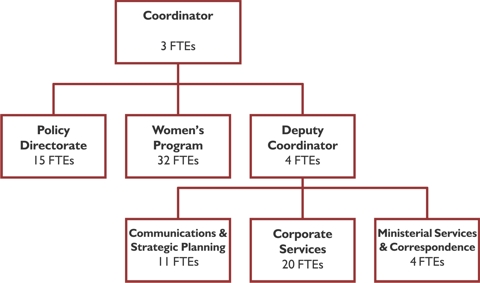
Program Activity Architecture Crosswalk
The table that follows provides resource information for the 2008–09 Main Estimates year by Program Activity Architecture (PAA).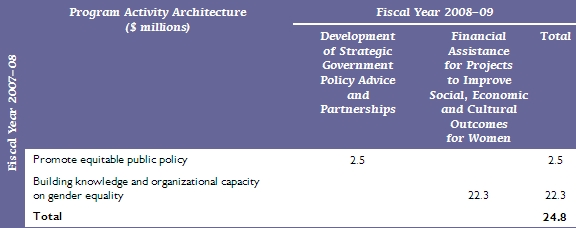
Voted and Statutory Items Displayed in the Main Estimates
This table provides resource information for the 2008–09 Main Estimates year by Vote and Statutory Item.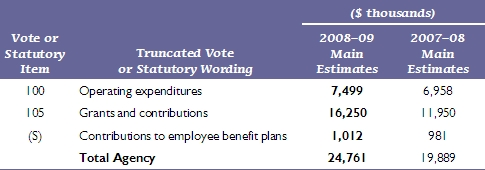
Budget 2007 provided additional funding to Status of Women Canada as a proactive measure to achieve concrete outcomes in key areas such as combating violence against women and girls and to enhance women’s economic security.
Departmental Planned Spending Table and Full-Time Equivalents
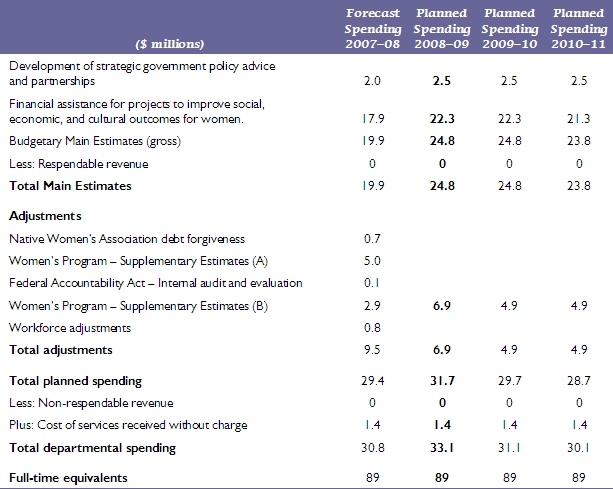
Budget 2007 provided additional funding to Status of Women Canada as a proactive measure to achieve concrete outcomes in key areas such as combating violence against women and girls and to enhance women’s economic security. An amount of $2.0 million in Grants and Contributions was approved for re-profiling from fiscal year 2007–08 to fiscal year 2008–09 to provide SWC effective time to fully distribute and manage the new funding. In fiscal year 2010–11, the reduction in planned spending from 2009–10 of $1 million is a result of the Sisters in Spirit initiative for which funding sunsets in 2009–10.
Summary Information
Financial resources ($ millions)
Human resources (FTEs)

Departmental Priorities
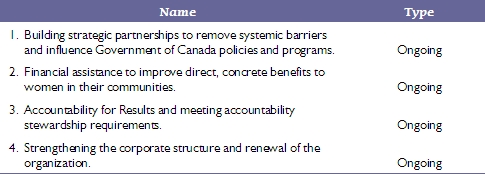
Program Activities by Strategic Outcome
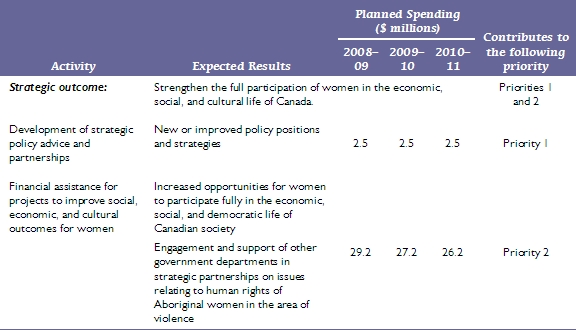
Departmental Plans and Priorities
For 2008–09, Status of Women Canada will be building on the work begun in the previous year which was a period of transition, change, and rebuilding. Specifically, it will continue to focus attention on specific policy areas related to women’s economic security and prosperity and to violence against women and girls by:- building strategic partnerships with federal departments, other levels of government, and international bodies to proactively ensure that systemic barriers are removed to ensure women’s full participation and leadership in society and to assist central agencies and departments in applying a gender perspective to policy and program development federally;
- funding specific projects through the Women’s Program and the Sisters in Spirit initiative;
- developing accountability mechanisms to monitor and measure progress; and
- strengthening the organizational structure of the Department to ensure its accountabilities are in line with overall Government of Canada accountabilities.
Building Strategic Partnerships
Through Status of Women Canada’s mandate to “coordinate policy with respect to the status of women and administer related programs”, the Department works with other federal departments and levels of government when designing and implementing policies and programs and coordinates policy development where many departments are implicated and no other department has the lead (i.e., Sisters in Spirit initiative).In addressing women’s economic security and prosperity, the Department is collaborating on the following key initiatives:
- Gender-based analysis (GBA) in support of policy and program development
- Supports for young families
- Removal of barriers to women’s role in long-term economic prosperity
- Addressing the needs of various groups of women in society, including Aboriginal women, immigrant and visible minority women, and girls.
Funding Through the Women’s Program
With the creation of two new funding components: the Women’s Community Fund and the Women’s Partnership Fund under the Women’s Program in 2007, the Program is an instrument to support women directly in their respective communities. For 2008–09, attention will be focused to ensure that the Women’s Program is effective and efficient in meeting its objectives of promoting the “equality and the full participation of women in the economic, social, and democratic life of Canada.”Funding Through the Sisters in Spirit Initiative
SWC will continue to work with the Native Women’s Association of Canada (NWAC) and to provide funding to address the underlying factors contributing to racialized, sexualized violence against Aboriginal women and their socio-economic, political, and legal status.Accountability for Results
Achieving concrete results requires the ability to track, monitor and measure progress, based on goals and objectives of public policies and programs tied to measurable outcomes. Status of Women Canada will continue work underway with central agencies and key departments on- integrating gender reporting into government accountability mechanisms, and
- creating a set of indicators on trends in the situation of women over time.
Strengthening the Corporate Structure
Fiscal year 2007–08 was a year of transition, change and rebuilding at Status of Women Canada. The organization will continue to focus on rebuilding, updating technology and systems, and ensuring Departmental accountabilities are in line with overall Government of Canada accountabilities. This includes responding to enhanced federal requirements regarding the administration of grants and contributions programs.Section II – Analysis of Program Activities by Strategic Outcome
Analysis by Program Activity
Strategic Outcome:Strengthen the full participation of women in the economic, social, and cultural life of Canada.
Program Activity Name:
Development of strategic policy advice and partnerships
Financial resources ($ millions)

Human resources (FTEs)

SWC collaborates on initiatives with other federal departments, provincial/territorial governments, civil society, and key international partners to address women’s issues. This program activity equally involves the development of strategic policy advice, tools, and partnerships to support federal departments and central agencies in integrating gender-based analysis in Government policies and programs, and in developing better evidence-based policy.
SWC will continue to work with federal, provincial, and territorial partners in identifying and supporting the removal of barriers to the equality of women in Canadian society. In 2008–09, SWC will provide support to selected departments on targeted and proposed government priorities in order to assist departments in meeting the specific needs of women, with a particular focus on Aboriginal women and women’s economic prosperity.
For Aboriginal women, SWC will continue to work with other federal, provincial, and territorial departments on evidence-based and culturally relevant policies and programs that address Aboriginal women’s human rights as well as their economic prosperity and legal status. In 2008–09, Status of Women Canada will work with other federal departments on the development of action plans in collaboration with Aboriginal women, the provinces, and territories to enhance Aboriginal women’s health, well-being, equality, and security in society. The strategies and key action plans will be discussed at the National Aboriginal Women’s Summit (NAWS) in July 2008. Specific NAWS recommendations encompass ensuring that economic opportunities and strategies consider all of the socio-economic conditions and cultural measures that are required to create the right environment for Aboriginal women to participate in the economy.
Through its Federal/Provincial/Territorial (F/P/T) forum, in 2008–09, SWC will continue to work on justice officials training related to Aboriginal women and violence in order to improve how Aboriginal women are treated by justice officials, as well as on the promotion of Aboriginal women to leadership positions to ensure their participation in decision-making and to support their economic prosperity.
Women are a vital economic and social resource in Canada, experiencing tremendous gains in areas such as education and labour force participation, but also significant constraints in terms of economic prosperity. In 2008–09, SWC will work on advancing women’s role in long-term economic prosperity by working with departments, with other governments, and with civil society representatives to identify gaps and suggest improvements, such as supports that enable women to address the earnings gap and social issues such as lack of adequate housing and violence prevention. SWC will also advance women and leadership initiatives, working with various partners.
SWC will continue to support departments and other stakeholders in integrating Gender-Based Analysis (GBA) in the design and implementation of key government priorities. Building on work on accountability mechanisms for the integration of GBA into all policies and programs, SWC will continue to support the central agencies in building their GBA capacity. In 2008–09, SWC will also provide support to other government departments to increase their capacity to conduct GBA in order to meet their accountabilities.
SWC will also monitor, collect, and analyze progress on gender equality and gender-based analysis, with a focus on generating knowledge and tools on gender issues and GBA practices. In 2008–09, the department will continue to generate evidence-based knowledge through the Gender Equality Indicator Project, which entails creating a set of indicators on trends in the situation of women and men over time.
In 2008–09, SWC will continue to further Canada’s domestic and foreign policy and meet Canada’s international obligations for advancing gender equality. SWC will meet international commitments and obligations by participating in key international activities (such as the United Nations Commission on the Status of Women) that support Canada’s role as a leader in promoting women’s equality in society and will share knowledge that advances the status of women.
Expected result: New or improved policy positions and strategies that strengthen women’s equality.
Performance indicator: Strategies/policies/initiatives are developed with key departments that address the situation of women in Canada.
Program Activity Name:
Financial assistance for projects to improve social, economic, and cultural outcomes for women
Financial resources ($ millions)

Human resources (FTEs)

WOMEN’S PROGRAM
In 2006, the terms and conditions of the Women’s Program were renewed, which resulted in changes to the program framework, including the mandate, objective, and outcomes in an effort to demonstrate linkages between WP funding and measurable, direct impacts on women.The Women’s Program delivery model was restructured, introducing two new components:
- The Women’s Community Fund: a grants and contributions fund for eligible recipients to carry out projects at the local, regional, or national level. This Fund solicits applications using calls for proposals targeted to priority issues and women’s populations; and
- The Women’s Partnership Fund: a contribution fund for collaborative projects that involve partners such as public institutions and non-governmental organizations. This Fund operates through an ongoing intake of funding requests.
Further refinements to the Women’s Program framework, including important changes to the mandate, objective, and outcomes were introduced in the 2007–08 fiscal year and will affect the delivery of the WP in 2008–09. Firstly, the “equality of women” component has been reintroduced in the mandate of the Women’s Program, to reinforce emphasis on women’s equality issues. Secondly, in addition to focusing on the key areas affecting the economic and social situation of women, the WP focus was expanded to encourage women’s participation in democratic life, which will contribute towards achieving the equality of women and their active contribution to Canadian society. Thirdly, outcomes were adjusted so that in addition to funding projects that have a direct impact on women in their communities, projects that address the broader context and bring benefits to women in the economic, social, and democratic life of Canada could be funded.
Furthermore, the Women’s Program no longer identifies priority populations (Aboriginal, seniors, ethnic, and immigrant minorities); it works to bring about the advancement of all women in Canada. Finally, the Women’s Program priority areas have been expanded to include areas such as economic prosperity and the elimination of all forms of discrimination against women. These changes will not only broaden the reach of the Women’s Program to include a larger segment of women across Canada, but also expand the scope of the WP. This comprehensive approach will enable the achievement of meaningful results for Canadian women and Canadians.
The Women’s Program obtained additional funding in the March 2007 budget, bringing the total funding level of grants and contributions funding from $11 million in 2006–07 to $21 million in 2008–09. It is expected that the increased funding to the Women’s Program will result in a continued increase in the numbers and types of organizations applying and receiving funding.
To improve women’s participation in all spheres of Canadian life, SWC will continue to provide financial assistance to women’s and other equality-seeking organizations addressing significant barriers to participation faced by Canadian women. As well, SWC will work to develop and strengthen partnerships with the public, non-profit, and private sectors, so that they may play a role in facilitating the full participation of women in Canadian society; this approach facilitates the ownership of “women’s issues” and helps make them societal issues.
In working toward bringing “increased benefits” and “increased opportunities” for women, SWC is focussing the Women’s Program on funding projects that will enhance and/or promote the equality of women and their full participation in the economic, social, and democratic life of Canadian society. This strategic outcome complements Status of Women Canada’s mandate, and is reinforced by the Canadian Charter of Rights and Freedoms and Canada’s adherence to the Convention on the Elimination of All Forms of Discrimination against Women (CEDAW). SWC will therefore contribute to the Government of Canada’s commitment to building a society that is inclusive and respectful of all Canadians.
During 2008–09 SWC will
- provide financial assistance to organizations addressing significant barriers to participation faced by women (for example, continue to increase the number and types of organizations applying and receiving funding, launch two calls for proposals for the Women’s Community Fund, and ongoing intake for the Women’s Partnership Fund);
- continue to provide technical support as well as information and training sessions to organizations (for example, facilitate networking of different groups that share a common goal, help groups gain access to, or provide access to resource materials and tools that help organizations work more effectively);
- work to develop and strengthen partnerships with the public, non-profit, and private sectors, so that they may play a role in facilitating the full participation of women in Canadian society;
- in line with the SWC priorities, the WP will continue to work closely with Aboriginal women’s and other organizations on issues such as prevention of violence and economic security in line with the SWC Sisters-In-Spirit initiative to address sexualized, racialized violence against Aboriginal women;
- better integrate SWC policy and programming with a focus on achieving more concrete results;
- continue to implement the SWC Management Response to the summative evaluation of the WP and the 2006 Integrated Results-Based Management Framework and Risk-Based Audit Framework (RMAF/RBAF) (for example, undertaking a review of the WP to gauge results, adopt best practices, and improve on areas of focus, strengthen monitoring and accountability mechanisms for the WP and the projects it funds, etc.)
- continue to streamline WP administration with more efficient and structured management strategies (for example, to assess proposals, developing guides and tools to better assist program officers and organizations, a greater investment in, and use of, information technology; a standard application and review process; and funding investment more targeted toward SWC priorities, etc.);
- conduct a formative evaluation of the implementation of the new WP.
Expected result: Increased opportunities for women to participate fully in the economic, social, and democratic life of Canada.
Performance indicator: Evidence of/degree of use of new knowledge, skills, and practices (for example, attitudinal shifts and changes in practices) and level of participation of women in their communities/societies.
SISTERS IN SPIRIT
In 2008–09, the fourth year of the five-year Sisters in Spirit (SIS) initiative, Status of Women Canada (SWC) will continue to work with the Native Women’s Association of Canada (NWAC) to address the underlying factors contributing to racialized, sexualized violence against Aboriginal women and their socio-economic, political, and legal status.SWC will work in collaboration with key government departments in developing and implementing policies, programs, services, and practices on four key policy areas: reduced violence; improved education and employment outcomes; safe housing; and access to justice.
These initiatives will aim at enhancing the rights and life conditions of Aboriginal women, thus reducing and ultimately eliminating violence against them.
SWC will promote and facilitate the creation of an Interdepartmental Steering Committee for the SIS initiative, with a mandate to provide strategic direction, review progress of work, and make decisions, as appropriate, for the work of the SIS Joint Working Group regarding strategies and approaches related to the implementation of SIS.
SWC will liaise, coordinate, and strategize with the Family Violence Initiative (FVI) Interdepartmental Working Group and the FVI-Provincial/Territorial Working Group, the FVI Working Group on Aboriginal Family Violence, the Federal/Provincial/Territorial Victims of Crime Working Group, the FPT Working Group on Missing Women, and, with our Ministers Responsible for the Status of Women counterparts, to address policy areas being put forward by NWAC and other Aboriginal women’s groups, by targeting specific areas for action to promote the safety of Aboriginal women.
Expected result: Engagement and support of other government departments in strategic partnerships on issues related to violence and Aboriginal women.
Performance indicator: Aboriginal women are positively impacted by policies, programs, and initiatives of federal departments which address the underlying causes of violence against Aboriginal women.
Section III – Supplementary Information
Table 1:Departmental Links to the Government of Canada Outcomes
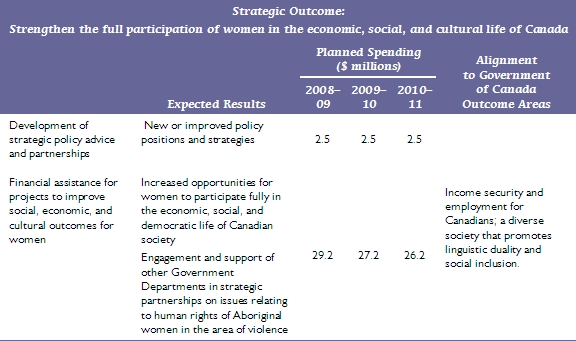
Below is a current list of tables that are available electronically on the Treasury Board Secretariat’s web site at http://www.tbs-sct.gc.ca/rpp/2008-2009/info/info-eng.asp:
- Details on transfer payment programs
- Evaluations
- Internal audits
- Services received without charge
Section IV – Other Items of Interest
Internal Services
- In 2007–08, Status of Women Canada began the process of “rebranding” the organization’s identity which will continue in 2008–09 and include the development of products for the organization to communicate more effectively.
- In 2007–08, Status of Women Canada initiated a plan to modernize its informatics infrastructure and systems; this work will continue into 2008–09 and will include improved reporting capacity and accountability on SWC’s activities.
Statutory and Departmental Reports
- Status of Women Canada Main Estimates: Report on Plans and Priorities
- Status of Women Canada Performance Report
www.swc-cfc.gc.ca/
Contact Information for the 2008–2009 Report on Plans and Priorities
For questions on financial information, contact:Cynthia Paquette
Director, Corporate Services
Telephone: 613-947-1453 Fax: 613-947-6113
E-mail: cindy.paquette@swc-cfc.gc.ca
For other questions, contact:
Dawn Nicholson-O’Brien
Deputy Coordinator
Telephone: 613-995-6409 Fax: 613-943-238
E-mail: dawn.nicholsonobrien@swc-cfc.gc.ca
Details on Transfer Payments Programs
|
Women’s Program |
|||||
|
Start date: 1973 |
End date: On-going |
||||
|
Description: The mandate of the Women’s Program is to advance the equality of women across Canada through the improvement of their economic and socialconditions and their participation in democratic life. |
|||||
|
Strategic outcome(s): Strengthen the full participation of women in the economic, social, and cultural life of Canadian society. |
|||||
|
Expected results: Increased opportunities for women to participate fully in the economic, social and democratic life of Canada. |
|||||
|
|
Forecast Spending |
Planned Spending |
Planned Spending |
Planned Spending |
|
|
Program Activity: Financial assistance for projects to improve social, economic and cultural outcomes for women. |
|||||
|
Total grants |
13.45 |
16.25 |
14.75 |
14.75 |
|
|
Total contributions |
3.7 |
4.7 |
4.2 |
4.2 |
|
|
Total other types of transfer payments |
0 |
0 |
0 |
0 |
|
|
Total program activity |
17.15 |
20.95 |
18.95 |
18.95 |
|
|
Planned evaluations |
n/a |
Formative |
n/a |
Summative |
|
|
Planned audits |
n/a |
n/a |
n/a |
n/a |
|
|
|
|
|
|
|
|
|
Sisters In Spirit |
|||||
|
Start date: 2005 |
End date: 2009-2010 |
||||
|
Description: The Sisters in Spirit Initiative addresses the underlying factors contributing to racialized, sexualized violence against Aboriginal women and their socio-economic, political and legal status. |
|||||
|
Strategic outcome(s): Strengthen the full participation of women in the economic, social, and cultural life of Canadian society. |
|||||
|
Expected Result: Engagement and support of other government departments in strategic partnerships on issues related to violence and Aboriginal women. |
|||||
|
|
Forecast Spending |
Planned Spending |
Planned Spending |
Planned Spending |
|
|
Program Activity: Financial assistance for projects to improve social, economic and cultural outcomes for women. |
|||||
|
Total grants |
0 |
0 |
0 |
0 |
|
|
Total contributions |
1.0 |
1.0 |
1.0 |
0 |
|
|
Total other types of transfer payments |
0 |
0 |
0 |
0 |
|
|
Total program activity |
1.0 |
1.0 |
1.0 |
0 |
|
|
Planned evaluations |
Formative |
n/a |
Summative |
n/a |
|
|
Planned audits |
n/a |
n/a |
n/a |
n/a |
|
|
|
|
|
|
|
|
Evaluations
| 1. Name of Evaluation | 2. Evaluation Type | 3. Status | 4. Expected Completion Date |
| Sisters in Spirit Formative Evaluation |
Transfer Payment |
Ongoing |
April 19, 2008 |
| Women’s Program Formative Evaluation |
Transfer Payment |
Planned |
March 31, 2009 |
| Women’s Program Summative Evaluation |
Transfer Payment |
Planned |
March 2011 |
| Sisters in Spirit Summative Evaluation |
Transfer Payment |
Planned |
March 2010 |
Internal Audits
| 1. Name of Internal Audit | 2. Audit Type | 3. Status | 4. Expected Completion Date | 5. Electronic Link to Report |
| Contracting and Procurement | Corporate | Planned |
September 2008 |
Contracting and Procurement |
Services Received Without Charge
|
2008-09 |
2009-2010 |
2010-2011 |
|
| Accommodation provided by Public Works and Government Services Canada |
0.84
|
0.85
|
0.86
|
| Contributions covering employers' share of employees' insurance premiums and expenditures paid by the Treasury Board of Canada Secretariat (excluding revolving funds) |
0.55 |
0.52 |
0.52 |
| Salary and associated expenditures of legal services provided by the Department of Justice Canada |
0.06
|
0.07
|
0.07
|
| Total services received without charge |
1.45 |
1.44 |
1.45 |